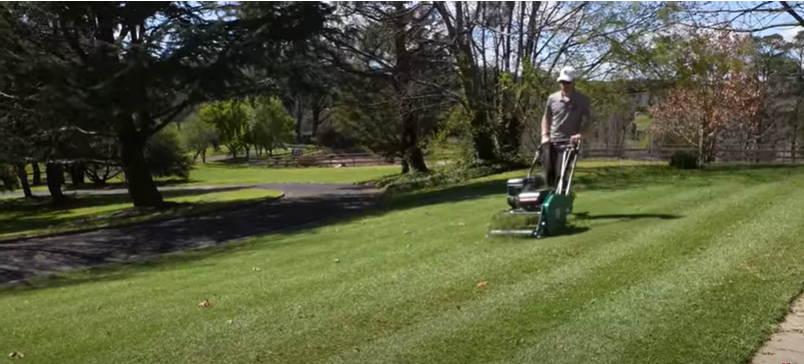Clearing the Thatch: Removing the Buildup of Dead Grass and Organic Matter
Maintaining a healthy lawn requires consistent effort and care. One important aspect of lawn care is removing thatch, which is a layer of dead grass, leaves, and other organic matter that accumulates between the soil surface and the green grass blades. While some thatch is natural and necessary for healthy lawn growth, too much of it can become problematic and inhibit the growth of a lush, green lawn.
Why Clearing the Thatch is Important
Thatch buildup can cause a number of issues for your lawn. Firstly, it can prevent water, air, and nutrients from reaching the roots of your grass. This can lead to a weak, shallow root system and ultimately result in a lawn that is more susceptible to drought and disease.
Secondly, a thick layer of thatch can create a breeding ground for pests and diseases. Insects and fungi can thrive in the warm, moist environment created by the thatch, potentially causing damage to your lawn.
Finally, thatch buildup can also cause cosmetic issues for your lawn. A thick layer of thatch can create an uneven surface and make it difficult to mow your lawn evenly. Additionally, a lawn with too much thatch may have a yellow or brownish tint, rather than the vibrant green color that most homeowners desire.
Methods for Removing Thatch
There are several methods for removing thatch, ranging from manual methods to mechanical tools. Let’s explore some of the most effective methods:
Raking
One of the simplest ways to remove thatch is to manually rake it out of your lawn. This method can be time-consuming, but it is effective for smaller lawns or for addressing localized areas of thatch buildup. To rake out thatch, simply use a leaf rake or a thatch rake to gently pull the thatch up from the soil surface. Be careful not to damage the grass blades or roots.
Power Raking
Power raking, also known as dethatching, is a mechanical method for removing thatch. A power rake is a machine that uses metal blades or tines to dig into the thatch layer and pull it up from the soil surface. This method is efficient and effective for larger lawns or for lawns with a thick layer of thatch. However, it can be damaging to the grass if not done correctly. It’s important to adjust the depth of the blades or tines to avoid damaging the grass roots.
Vertical Mowing
Vertical mowing, also known as vertical cutting, is another mechanical method for removing thatch. This method uses a machine with rotating blades to cut vertically into the thatch layer and pull it up from the soil surface. Vertical mowing is particularly effective for lawns with a thick layer of thatch or for lawns with a lot of foot traffic. However, like power raking, it can be damaging to the grass if not done correctly.
Aerating
Aerating, also known as core aeration, is a method for removing thatch and improving soil health at the same time. This method involves using a machine to remove small plugs of soil from the lawn, which helps to loosen compacted soil and allow water, air, and nutrients to reach the roots of the grass. The plugs of soil that are removed also help to break up the thatch layer and distribute it more evenly throughout the lawn.
When to Remove Thatch
The best time to remove thatch depends on the type of grass you have and the climate in your area. For warm-season grasses, such as Bermuda grass and St. Augustine grass, the best time to remove thatch is in the late spring or early summer, after the grass has started actively growing. For cool-season grasses, such as Kentucky bluegrass and fescue, the best time to remove thatch is in the fall, after the grass has stopped actively growing.
It’s important to note that removing too much thatch at once can be damaging to the grass, so it’s best to remove it gradually over time. For example, you might remove one-third of the thatch one year, and then wait a year or two before removing another one-third.
Preventing Thatch Buildup
While it’s important to remove thatch when it becomes excessive, it’s also important to prevent thatch buildup from occurring in the first place. Here are a few tips for preventing thatch buildup:
Mow regularly
Regular mowing can help to prevent thatch buildup by removing some of the organic matter before it has a chance to accumulate. It’s important to mow at the correct height for your grass type, as mowing too low can stress the grass and encourage thatch buildup.
Water deeply and infrequently
Watering deeply and infrequently can help to prevent thatch buildup by encouraging deep root growth and minimizing the amount of organic matter that accumulates on the soil surface.
Avoid over-fertilizing
Over-fertilizing can encourage rapid grass growth, which can result in excessive thatch buildup. It’s important to follow a fertilization schedule that is appropriate for your grass type and climate.
Aerate regularly
Regular aeration can help to prevent thatch buildup by loosening compacted soil and improving air and water circulation in the soil.
Clearing the thatch is an important aspect of lawn care that can improve the health and appearance of your lawn. Whether you choose to remove thatch manually or with a mechanical tool, it’s important to do so gradually and at the appropriate time for your grass type and climate. Additionally, taking steps to prevent thatch buildup, such as regular mowing and deep watering, can help to maintain a healthy and vibrant lawn for years to come.

